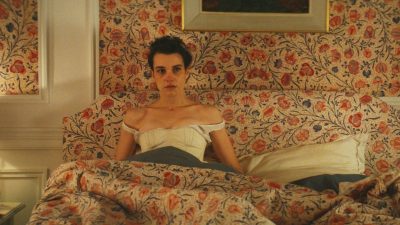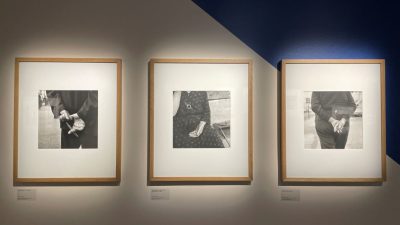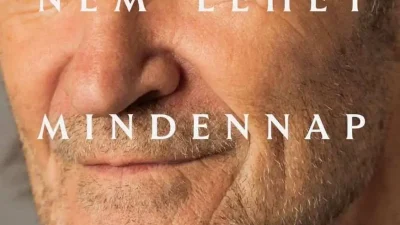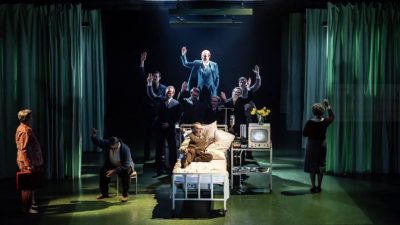The Brutalist, Brady Corbet’s latest film, is not just a movie—it is an event. At least, that is how I convinced myself when I decided to trade my cozy white winter jumper for a black blazer and vest. Dressing up for a three-hour-long, intermission-equipped screening might sound a bit dramatic, but this film calls for some reverence. And I had no idea, but it definitely ends up feeling like the cinematic burial of the American Dream.
A mix of Kubrickian ambition, and Bergman-like introspection, The Brutalist is anything but casual Sunday viewing. Tight bun? Check. Dark lipstick? Why not? By the time the lights dimmed, I felt ready to step into a post-World War II immigrant architect chasing a better, safer life—in a country that often does not seem to want him.

Source: The New Yorker
At its core, The Brutalist tells the story of László Tóth (Adrien Brody), a Hungarian-Jewish architect and Holocaust survivor who migrates to the United States – where he is joined by his wife, Erzsébet (Felicity Jones) around midway through the movie, in search of a better life. The couple arrives with little more than their talent, ambition, and a desire to rebuild their lives. László’s modernist designs catch the attention of wealthy industrialist Van Buren (Guy Pearce), who commissions a monumental community building that László hopes will revive his career and his self-confidence as an artist.
But the path to success is fraught with betrayal, exploitation, and the haunting memories of a war-torn past. Erzsébet’s resilience shines as she navigates hunger, illness, and the challenges of caring for Zsófia (Raffey Cassidy), their niece who has suffered deeply as a young child during the Holocaust. The film unfolds as a mosaic of moments: László’s clashes with other architects and advisors of Van Buren, Erzsébet’s loving strength, Zsófia’s quiet Brechtian surrender and the Tóth family’s struggle to hold onto their humanity and sanity in a world that seeks to exploit them.
From the very first frame, Corbet hooks you with intimacy. The opening sequence pulls you in with uncomfortably close shots reminiscent of Son of Saul. László, played with magnetic intensity by Brody, emerges amid shouting, warm hues, and long takes (with some invisible cuts). It is a sensitive and smart way to throw the audience into his world—a place of personal struggle and artistic ambition, where the camera does not just follow; it breathes down our protagonist’s neck.
This movie’s love affair with close-ups does not seem to be just an aesthetic choice. It is practical too, born from a modest $10 million budget. But here is the genius: Corbet takes that limitation and turns it into a strength. That is why The Brutalist becomes a real triumph. By narrowing our view, he amplifies the emotional gravity. It is like reading a novel written entirely in whispers—you cannot help but lean in closer. I think both Sean Baker (Anora) and Corbet showed the world this year that there is something tremendously off in Hollywood, with the kind of money that floods into mindless projects and is kept far from gifted filmmakers.
If The Brutalist feels like an ode to cinema, that is because it is. The director borrow textures, moods, and styles from the greats—Fellini, Kubrick, Lean—and somehow stitches them together, if sometimes chaotic, tapestry. One moment, you are enveloped in the robust, ‘monstrous’ soundtrack, a sweeping nod to classic 1950s and ’60s films. Next, you are watching an outdoor scene near Philadelphia that feels plucked straight out of Bergman, as characters wander through the hillside.

Source: Condée Nast
The mix of styles is not just ambitious—it is experimental. The young actor-director dips his toes into different genres like a painter testing a dozen brushes. Long, dialogue-heavy scenes between Guy Pearce’s Van Buren and Brody’s László give way to montages that play like fragmented memories, or sometimes: postcards, and to archival footage. The result is a film that is not always smooth but undeniably alive. It is as if Corbet is daring us to follow his train of thought, he treats his viewers as intelligent and curious adults, which is not so common from today’s filmmakers.
Now, let’s talk about that budget for a moment. In an era when even Kevin Hart comedies can cost $50 million, The Brutalist delivers a grandiose immigrant story for a fraction of that. How? By leaning into smart filmmaking. Hungary stands in for Philadelphia. Archival footage and public domain clips lend texture. Italian marble quarries—poetically shot in muted whites and blues—become the backdrop for some of the film’s most stunning sequences. These choices are not just economical; they are integral to the story, feeding into the narrative’s authenticity.
One standout scene takes us to Tuscany, where László reconnects with an old Italian friend, Orazio, a marble supplier who feels more like a Renaissance god than a businessman. Long hair, flowing beard, unapologetically late to their meeting—he embodies a kind of laid-back charm that contrasts sharply with László’s Hungarian pragmatism and Van Buren’s unapologetic “let’s do this, bro” American approach. And yes, the morning espresso humor is spot-on. Italians, after all, do not rush for anything, not even plot advancement.
Another scene I have particularly liked is the opera-like dinner table sequence —where Erzsébet interrupts a tense gathering. No spoilers, but it stands out for its theatrical intensity and emotional weight. Tragic and powerful.
Speaking of Hungarian pragmatism, Adrian Brody brings an authenticity to László that is hard to ignore. Maybe it is his Hungarian roots—his mother, Sylvia Plachy is a Budapest-born photographer—but his portrayal feels lived-in, as if he is drawing from something deeply personal. László’s journey, from post-war Europe to the promise of America, is filled with both grandeur and grit. Brody plays him as a man of contradictions: idealistic yet cautious, bold yet quietly burdened by the ghosts of his past, and sly like a fox yet deeply innocent.
Felicity Jones brings warmth and quiet power to Erzsébet, whose strength and intelligence anchor the narrative – as well as László’s life. She captures the depth of a woman who instead of a victim becomes a survivor – after starvation, illness, and unimaginable loss she continues to fight for her family’s survival. Guy Pearce shines as the manipulative, endearing, typical American businessman whose life has little to no emotional depth.
If there is one criticism to level at The Brutalist, it is the rhythm. At times, the pacing feels choppy—elongated scenes suddenly give way to abrupt transitions, the script fluctuates strangely quite a bit. It does not feel like a dynamic born out of intention; it is more like hitting a speed bump when you were just starting to cruise. But even in its unevenness, the film remains compelling. It is messy, sure, but so is the immigrant experience it seeks to portray.
What the script occasionally lacks in flow, the cinematography (Lol Crawley) more than makes up for. From the dusty, intimate warmth of Philadelphia to the cool, marble elegance of the “birthplace” of Michelangelo’s Pietá, every frame feels meticulously crafted. Corbet’s collaborator, editor Dávid Jancsó, deserves a special mention. The editing elevates the film, weaving together its disparate styles into something that is undeniably captivating. And despite its strengths, The Brutalist falters in its conclusion. The ending, set at the 1980 Venice Biennale, feels flat and anticlimactic, offering little in the way of resolution or catharsis.

Source: Filmlinc
At its heart, The Brutalist is about building something lasting—be it a monumental art project (nice parallel between the many requirements of architecture and filmmaking), a legacy, or a life in a foreign land. In an age where fiery debates related to immigration dominate headlines, this project feels particularly resonant. It is a reminder of the dreams and sacrifices that shape not just individual lives but entire nations, and how easily a lack of empathy turns us from humans into monsters.
In the end, I walked out of the theater, blazer slightly wrinkled, stomach filled with popcorn, lipstick slightly smudged, but pretty happy. It may not be a film for everyone, but for those willing to embrace its experiments and imperfections, The Brutalist is a bold and rewarding journey. One that reinforces the fact that you can tell any story and execute any project if you are able to make your constraints work for you.
Catch The Brutalist at your local theatre.
~ by Dora Endre ~


























